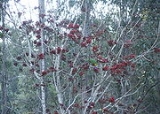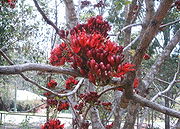
Schotia brachypetala
Encyclopedia

Fabaceae
The Fabaceae or Leguminosae, commonly known as the legume, pea, or bean family, is a large and economically important family of flowering plants. The group is the third largest land plant family, behind only the Orchidaceae and Asteraceae, with 730 genera and over 19,400 species...
(bean family/pod-bearing family/legumes) and the sub-family Caesalpinioideae
Caesalpinioideae
Caesalpinioideae is a botanical name at the rank of subfamily, placed in the large family Fabaceae or Leguminosae. Its name is formed from the generic name Caesalpinia....
. It has many common names, including (but not limited to) Weeping Boerbean, Huilboerboon, Tree Fuchsia, and African Walnut.
Habit
A medium to large, spreading tree, growing up to 20 metres, but more commonly from 5 to 10 metres depending on conditions. Canopy spread can vary between 5 to 15 metres. Trees grown in poor soil or in very dry conditions tend to be smaller (about 5 metres tall with a 5 metre canopy spread) and more sparsely foliaged. Trunk form varies from specimens with single trunks to low-branching specimens with multiple trunks. Leaves are compound, composed of four to eight pairs of leaflets, each with an entire, wavy margin attached to a stem. Bark is smooth and varies from grey to light brown from tree to tree. Flowers are numerous, a deep red, and filled with nectar. Flowers generally appear in Spring, although exact flowering times vary from tree to tree. The fruit is a hard, woody pod about 15 cm long that splits on the tree releasing the seeds, each attached by a fleshy, yellow arilAril
An aril is any specialized outgrowth from the funiculus that covers or is attached to the seed. It is sometimes applied to any appendage or thickening of the seed coat in flowering plants, such as the edible parts of the mangosteen and pomegranate fruit, the mace of the nutmeg seed, or the...
.
Distribution
A native of the southern parts of Africa, mainly sub-tropical. Its northernmost extent is on the edge of the MashonalandMashonaland
Mashonaland is a region in northern Zimbabwe. It is the home of the Shona people.Currently, Mashonaland is divided into three provinces, with a total population of about 3 million:* Mashonaland West* Mashonaland Central* Mashonaland East...
Plateau just south of the Zambezi
Zambezi
The Zambezi is the fourth-longest river in Africa, and the largest flowing into the Indian Ocean from Africa. The area of its basin is , slightly less than half that of the Nile...
valley in Zimbabwe
Zimbabwe
Zimbabwe is a landlocked country located in the southern part of the African continent, between the Zambezi and Limpopo rivers. It is bordered by South Africa to the south, Botswana to the southwest, Zambia and a tip of Namibia to the northwest and Mozambique to the east. Zimbabwe has three...
at about 17°S. It grows southwards to the eastern parts of South Africa
South Africa
The Republic of South Africa is a country in southern Africa. Located at the southern tip of Africa, it is divided into nine provinces, with of coastline on the Atlantic and Indian oceans...
, generally not near the coast but usually on hills away from the coastal winds and further inland. It southernmost extent is southwest of East London in the Eastern Cape
Eastern Cape
The Eastern Cape is a province of South Africa. Its capital is Bhisho, but its two largest cities are Port Elizabeth and East London. It was formed in 1994 out of the "independent" Xhosa homelands of Transkei and Ciskei, together with the eastern portion of the Cape Province...
of South Africa at about 33°S. It is a tree of woodland rather than forest.
Ecology
The weeping schotia is nowhere common but is usually scattered among other more dominant woodland trees. It grows best when there is ample summer rain and prefers a notable cool spell during its winter resting period. In Zimbabwe it is widespread at altitudes over 1200 metres in areas with more than 700mm annual rainfall, usually in BrachystegiaBrachystegia
Brachystegia is a genus of tree of the sub-family Caesalpinioideae that is native to tropical Africa. Trees of the genus are commonly known as Miombo, and are the predominant tree in the Miombo woodlands of central and southern Africa.-Species:...
woodland, while the best specimens grow in the midlands of Kwazulu-Natal
KwaZulu-Natal
KwaZulu-Natal is a province of South Africa. Prior to 1994, the territory now known as KwaZulu-Natal was made up of the province of Natal and the homeland of KwaZulu....
at an altitude of about 900 - 1200 metres.
Inland it is usually deciduous, especially where the winter season is very dry or there is risk of frost. The tree gets its new leaves in spring, usually early to mid-September. The new leaves are a very showy bright red as with many savanna trees. The red colour fades through bronze to dark green over a period of 7–10 days. The red flowers are produced straight after the new leaves during September and October and are very attractive to bees. They sometimes produce so much nectar that it drips out of the flowers.
Alternative names

Cultivation
Schotia is an easily grown tree, and is remarkably hardy in both poor soil and very dry conditions. Adverse conditions will affect the growth rate, with poor conditions considerably slowing the speed of growth. In good quality, well-drained soil with plenty of moisture the tree grows very quickly, easily reaching 5 metres within a few years. It is fairly widely cultivated outside its natural range in warm temperate and subtropical climates, particularly in AustraliaAustralia
Australia , officially the Commonwealth of Australia, is a country in the Southern Hemisphere comprising the mainland of the Australian continent, the island of Tasmania, and numerous smaller islands in the Indian and Pacific Oceans. It is the world's sixth-largest country by total area...
, where it is a common street tree, it has been planted also in Spain
Spain
Spain , officially the Kingdom of Spain languages]] under the European Charter for Regional or Minority Languages. In each of these, Spain's official name is as follows:;;;;;;), is a country and member state of the European Union located in southwestern Europe on the Iberian Peninsula...
.

